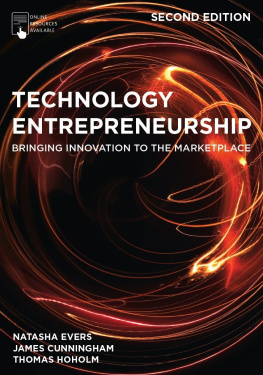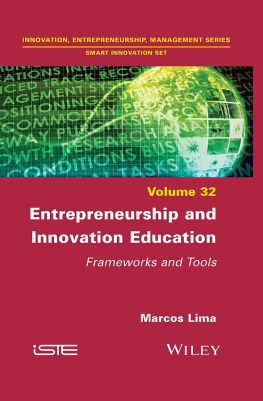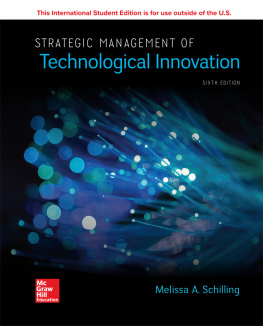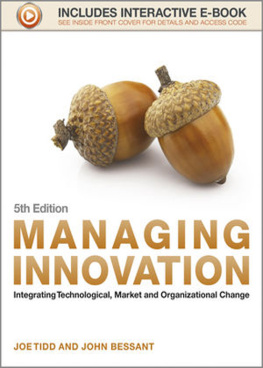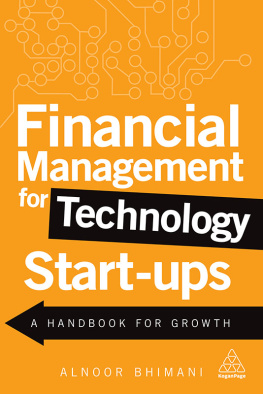
TECHNOLOGY ENTREPRENEURSHIP
TECHNOLOGY ENTREPRENEURSHIP
BRINGING INNOVATION TO THE MARKETPLACE
NATASHA EVERS
JAMES CUNNINGHAM
THOMAS HOHOLM
SECOND EDITION

Natasha Evers, James Cunningham, Thomas Hoholm and The Authors, under exclusive licence to Macmillan Education Limited 2014, 2021
All rights reserved. No reproduction, copy or transmission of this publication may be made without written permission.
No portion of this publication may be reproduced, copied or transmitted save with written permission or in accordance with the provisions of the Copyright, Designs and Patents Act 1988, or under the terms of any licence permitting limited copying issued by the Copyright Licensing Agency, Saffron House, 610 Kirby Street, London EC1N 8TS.
Any person who does any unauthorized act in relation to this publication may be liable to criminal prosecution and civil claims for damages.
The authors have asserted their rights to be identified as the authors of this work in accordance with the Copyright, Designs and Patents Act 1988.
This edition published 2021 by
RED GLOBE PRESS
Previous editions published under the imprint PALGRAVE
Red Globe Press in the UK is an imprint of Macmillan Education Limited, registered in England, company number 01755588, of 4 Crinan Street, London, N1 9XW
Red Globe Press is a registered trademark in the United States, the United Kingdom, Europe and other countries.
ISBN 978-1-352-01117-3 paperback
This book is printed on paper suitable for recycling and made from fully managed and sustained forest sources. Logging, pulping and manufacturing processes are expected to conform to the environmental regulations of the country of origin.
A catalogue record for this book is available from the British Library.
A catalog record for this book is available from the Library of Congress.
To my father Brian and my late mother Marie,
and to Sen, Catherine and Cillian.
To my loving and supportive family Sammi, Aiden and Riley
and in loving memory of Mary Ann Conboy
To Camilla, Sebastian, Rasmus, Oliver and Linus:
Thank you for keeping up with me.
CONTENTS
LIST OF FIGURES AND TABLES
FIGURES
TABLES
PREFACE
The knowledge and skills required to transform science and technology into commercial innovation are commonly termed technopreneurship. Local regional development can be driven by technopreneurs (Venkataraman, 2004; Lee and Wong, 2004). Technopreneurs are scientists, lab technicians, engineers and technologists who utilise their technical knowledge and know-how to establish business ventures. Technology entrepreneurship is to the fore for policy-makers, support agencies, venture capitalists, technology transfer professionals and academic entrepreneurs. The past two decades have witnessed a dramatic increase in investment in technology entrepreneurship. Moreover, Covid-19 has further highlighted the importance of technology and technology entrepreneurship to national economies and societies. The translation of the discovery, development and diffusion of technological innovations at the national level has become a part of the innovation and economic agenda for every developed economy in Europe, against the background of increased uncertainty and competition from Asian economies and China. Across primary- and secondary-level education, there has been greater emphasis on national education policies and curriculum choices in the subjects of science, technology, engineering and mathematics (STEM) to improve competitiveness in science and technology development.
The importance of transferring knowledge and technology, encompassing intellectual property, from higher education institutions (HEIs) and public research organisations (PROs) has been highlighted in Europe through the EU Innovation Scorecard. The founding of small, start-up firms developing inventions and technology with significant potential commercial application is critical to the success of innovative and entrepreneurial economies and societies. Such processes can be referred to as technology entrepreneurship.
Technology entrepreneurship is defined as an investment in a project that assembles and deploys specialised individuals and heterogeneous assets that are intricately related to advances in scientific and technological knowledge for the purpose of creating and capturing value for a firm (Bailetti, 2012, p. 5).
The ability to connect specific knowledge and a commercial opportunity requires a set of skills, aptitudes, insights and circumstances that are distributed neither uniformly nor widely (Venkataraman, 1997). In creating a new venture, scientists, engineers and technologists can be involved in both the invention and the commercialisationexploitation phases (Evers and Andersson, 2019; Grandi and Grimaldi, 2005); thus, they need scientific knowledge and business, leadership and managerial skills (Cunningham and OReilly, 2019).
There is a critical knowledge and skills deficit among the science and technology community for commercialising technological discoveries arising from their research and industry experience. Many technical entrepreneurs are in love with their product and tend to forget to think about how to build a business around it. Often this leads to business plans with very convincing technology and product descriptions, but with no sign of how this will create value for customers and owners, and how to organise the business in order to capture (a share of) the economic value so as to profit from it. Research shows clearly how companies within the same industry may have very different abilities to capture economic value from their business models.
At the individual and group level, a key challenge is how to translate promising technologies into a stream of economic returns for their founders, investors and employees. In other words, the main problem is not so much invention but commercialisation (Gans and Stern, 2003). Techno-entrepreneurs need to achieve a good product-market fit in the early stages for building sustainable and scalable high-technology new ventures. This book is focused on providing an academic grounding and practical approaches that address the knowledge and skills deficit through a variety of pedagogical supports.
CORE AIMS OF THE BOOK
This book caters to pre- and post-experience business and STEM students by providing them with the knowledge, skills and practical approaches required to transform scientific ideas into commercial innovation for enterprise development and the commercial agenda around issues of discovery, development and diffusion of technological innovations. It gives the reader a sufficient theoretical grounding as well as practical approaches and frameworks that assist in and manage the transformation of scientific discovery for profit and/or for social purpose. It integrates both an academic and a practitioner perspective of key approaches involved in managing, commercialising and marketing technological innovation and new business development. The book introduces the learner to adopting an entrepreneurial marketing perspective by engaging them in a process of evaluating opportunities so as to create perceived customer value through relationships by employing innovativeness, creativity, selling, market immersion, networking and flexibility. In particular, strong emphasis is placed upon the development of the value proposition and the business model as important business development and planning tools. There are three chapters () devoted to decisions most pertinently related to the strategic marketing of technologies and international marketing decisions in high-tech ventures. The book further commits a full chapter to the mechanics of team organisation, leadership and the cross-disciplinary nature of entrepreneurial teams in technology-based ventures.
Next page
